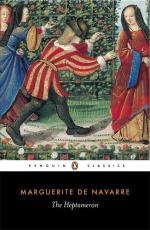Now when this good company had assembled at Serrance and told each other their misadventures, the waters on inquiry seemed to be out more widely and more dangerously than before, so that it was impossible to think of going farther for the time. They deliberated accordingly how they should employ themselves, and, after allowing, on the proposal of Oisille, an ample space for sacred exercises, they resolved that every day, after dinner and an interval, they should assemble in a meadow on the bank of the Gave at midday and tell stories. The device is carried out with such success that the monks steal behind the hedges to hear them, and an occasional postponement of vespers takes place. Simontault begins, and the system of tale-telling goes round on the usual plan of each speaker naming him or her who shall follow. It should be observed that no general subject is, as in the Decameron, prescribed to the speakers of each day, though, as a matter of course, one subject often suggests another of not dissimilar kind. Nor is there the Decameronic arrangement of the “king.” Between the stories, and also between the days, there is often a good deal of conversation, in which the divers characters, as given above, are carried out with a minuteness very different from the chief Italian original.
From what has been said already, it will be readily perceived that the novels, or rather their subjects, are not very easy to class in any rationalised order. The great majority, if they do not answer exactly to the old title of Les Histoires des Amants Fortunes, are devoted to the eternal subject of the tricks played by wives to the disadvantage of husbands, by husbands to the disadvantage of wives, and sometimes by lovers to the disadvantage of both. “Subtilite” is a frequent word in the titles, and it corresponds to a real thing. Another large division, trenching somewhat upon the first, is composed of stories to




